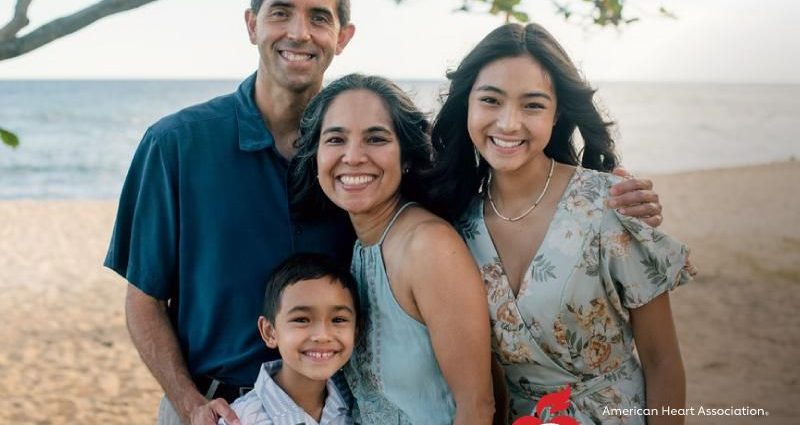WEDNESDAY, Feb. 8, 2023 (American Heart Association News) — After their Hawaii honeymoon, newlyweds Jackie Ng-Osorio and her husband, Kane, set a goal of training together for the Honolulu Marathon.
The race went well. Afterward, Ng-Osorio, who was 26 at the time, eased back into shorter daily runs. But she noticed her heart rate stayed high well after running.
She went to her doctor. A treadmill stress test found no problems. “You could stop running,” her doctor suggested. But Ng-Osorio, a runner in high school, college and graduate school, found joy in the sport. She didn’t want to stop.
Months later, in addition to her heart rate remaining elevated after exercising, she also felt sluggish.
Before work one morning, she joined friends for a run around Honolulu. When she returned to the office to shower, Ng-Osorio felt like her heart was pushing through her chest.
“You look awful,” a co-worker told her.
She left for her doctor’s office. Her heart was racing so fast that the doctor called 911. Paramedics measured her heart rate at 200 beats per minute and began using ice packs and medicine to try to slow it.
In the emergency room, her chest pain got worse. It felt like an elephant was sitting on her chest.
Kane had just started a new job. He was at work when he got a call that his wife was in the ER. “You feel helpless,” he said. “All I could do was just be there for her.”
Over a weeklong hospital stay, Ng-Osorio was diagnosed with supraventricular tachycardia, a fast heartbeat that originates in the heart’s upper chambers. The extra beats come from an extra electrical pathway in her heart.
Doctors performed an ablation, essentially burning away the unwanted pathway. The procedure appeared to work and she went home.
But over the next six weeks, she was in and out of the ER with a fast heartbeat. She wore a mobile electrocardiogram to track her heart rate. After another episode, she had a second ablation.
Ng-Osorio soon found the opposite problem; her heart rate wouldn’t rise over 50 to 60 beats per minute. At a regular cardiology appointment, she had an EKG. Looking at the results, the doctor told her, “You have to get to the ER now.”
She had complete heart block, which happens when the heart’s electrical signal can’t pass normally from the heart’s upper to lower chambers. She needed a pacemaker.
Ng-Osorio’s only experience with a pacemaker was with her grandmother. She associated the device with older people. “I didn’t really know what it did,” she said.
She was hooked up to a machine to keep her heart beating normally until surgery.
“That was one of the scariest moments,” she said.
The surgery went well. Ng-Osorio went home bound with bandages, and Kane and her mom helped dress her and brush her hair as she recovered. She searched online for, “What can I do with a pacemaker?” and, “Can I have kids with a pacemaker?”
As she healed, she wanted to connect with young people who had experienced something similar. She linked up with a local survivors group. But members were in their 60s and dealing with heart attacks and bypasses.
She found a pacemaker club online and other people’s stories comforted her. She also reached out to the American Heart Association and began volunteering. She participated in Heart Walks and started sharing her story during community events.
“It’s been important for me to be a voice, because that’s the best thing I have to offer,” she said. “Electrical problems aren’t talked about as much because they’re unseen.”
Ng-Osorio returned to school and got her doctorate in public health. She and Kane now have two children, Petra, who’s 14, and Tobias, 8.
Critical for her recovery, too, has been her return to running. Ng-Osorio’s first run after surgery was a combination of running and walking.
“My legs wanted to go so much faster than my heart could go initially,” she said.
Gradually, she walked less and ran more. She set the goal of completing another race, the Nike Women’s Marathon in San Francisco. Two years after her heart issues began, she completed the race with Kane.
She ran to raise money for children with leukemia. Although she became a volunteer with no personal connection to the cause, she quickly developed an affinity for the organization and the people – particularly the kids. When she competed, she wrote on her arms and legs the names of the children who inspired her. If she needed motivation midrace, those names provided it.
“I think that marathon helped her push through,” said Kane, “and to believe that she could manage her condition and be active. She’s very tenacious and strong.”
This August marks 20 years since Ng-Osorio’s first pacemaker. Now 46, she’s on her third device. “I’m forever grateful for this technology,” she said.
She continues to find fulfillment in sharing her story. “I never asked myself the ‘why me,'” she said. “What I chose to do is to take my experience and shed light for other people.”
American Heart Association News covers heart and brain health. Not all views expressed in this story reflect the official position of the American Heart Association. Copyright is owned or held by the American Heart Association, Inc., and all rights are reserved. If you have questions or comments about this story, please email editor@heart.org.
By Deborah Lynn Blumberg, American Heart Association News
Copyright © 2025 HealthDay. All rights reserved.

